Identification of anticoagulation quality in patients using warfarin and associated factors
DOI:
https://doi.org/10.15343/0104-7809.202145003009Keywords:
Warfarin, Use of medicines, AnticoagulantsAbstract
Warfarin is an oral anticoagulant widely used in the prevention of thromboembolic events and is made available by the Brazilian Unified Health System. However, maintaining the quality of oral anticoagulation is a challenge in clinical practice, other than the identification of factors that interfere in this important process for the clinical and scientific context. This was a cross-sectional study, conducted at a university hospital in Minas Gerais, with the objective of identifying the quality of oral anticoagulation in patients using warfarin and associated factors. The quality of anticoagulation was assessed using the time in therapeutic range (TTR), which allows the identification of the proportion of time in which the patient presented international normalized ratio (INR) values within the desired therapeutic range. TTR values were associated with clinical and demographic characteristics using univariate and multivariate logistic regression. The mean TTR was 61.8% (SD + 1.00), with 204 (46.3%) patients demonstrating inadequate anticoagulation control. The variables gender (OD: 1.82; P: 0.005; CI: 1.204335-2.761345), use of warfarin other than prescribed (OD: 2.81; P <0.005; CI: 1.700- 4.632352) and bleeding occurrence (OD: 1.70; P <0.005; CI: 1.013157-4.632352) were predictors of inadequate TTR. Indications for use, thromboembolism and valvulopathy were predictors of adequate TTR. The findings contribute to a better understanding of the profile of patients with inadequate control of oral anticoagulation and the establishment of strategies that promote anticoagulation quality.
Downloads
References
Rev. 2019; 15(2):136–44. doi: 10.2174/1573403X15666181205110624.
2. Zimerman LI, Fenelon G, Martinelli Filho M, Grupi C, Atié J, Lorga Filho A, et al. Sociedade Brasileira de Cardiologia. II Diretrizes
brasileiras de fibrilação atrial. Arq Bras Cardiol. 2016; 106 (4 supl.2):1-22. doi:: 10.5935/abc.20160055.
3. Wolf PA, Abbott RD, Kannel WB. Atrial fibrillation as an independent risk factor for stroke: the framingham study. Stroke. 1991;
(8):983-88. doi: 10.1161/01.str.22.8.983.
4. Gregory YHL, Amitava B, Giuseppe B, Chern C, et al. Antithrombotic therapy for atrial fibrilation. Chest. 2018 ;154(5):531-75. doi
10.1016/j.chest.2018.07.040.
5. Katzung B G et al. Farmacologia Básica e Clinica. 10. ed. São Paulo: Mc Graw Hill, 2014.
6. Gateman D, Trojnar ME, Agarwal G. Time in therapeutic range: warfarin anticoagulation for atrial fibrillation in a community-based
practice. Can Fan Physician 2017;63:425-31. Disponível em: doi: 10.1111/j.1538-7836.2008.03075.x.
7. Witt DM, Niewlaat R, Clark NP, Ansell J, Holbrook A, Skov J, et. Al. American Society of Hematology 2018 guidelines for management
of venous thromboembolism: optimal management of anticoagulation therapy. Blood Adv. 2018 27;2(22):3257–91. doi: 10.1182/
bloodadvances.2018024893.
8. Marsh EB, Llinas RH, Schneider ALC, Hillis AE, Lawrence E, Dziedzic P, et al. Predicting hemorrhagic transformation of acuteischemic
stroke prospective validation of the hers score. Medicine (Baltimore). 2016;95(2):1-8. doi: 10.1097/MD.0000000000002430.
9. Rose AJ, Hylek EM, Ozonoff A, Ash AS, Reisman JI, Berlowitz DR, et al. Risk-adjusted percent time in therapeutic range as a quality
indicator for outpatient oral anticoagulation results of the veterans affairs study to improve anticoagulation. Circ Cardiovasc Qual
Outcomes. 2011; 4:22-29. doi: 10.1161/CIRCOUTCOMES. 110957738.
10. Connolly SJ, Pogue J, Eikelboom J, et al. Benefit of oral anticoagulant over antiplatelet therapy in atrial fibrillation depends on
the quality of international normalized ratio control achieved by centers and countries as measured by time in therapeutic range.
Circulation. 2008;118(20):2029-37. doi: 10.1161/CIRCULATIONAHA.107.750000.
11. Prochaska JH, Gobel S, Keller K, Coldewey M, Ullmann A, Lamparter H, et al. Health based management of patients receiving
oral anticoagulation therapy: results from the observational thrombEVAL study. J Thromb Haemost. 2017;15(7):1375-85. doi: 10.1111/
jth.13727.
12. Martins MAP, Costa JM, Mambrini JVM, Ribeiro ALP, Benjamin EJ, Brant LCC, Paasche-Orlow MK, Magnani, JW. Health literacy
and warfarin therapy at two anticoagulation clinics in Brazil. Heart. 2017;103(14):1089-95. doi: 10.1136/heartjnl-2016-310699.
13. Singer DE, Hellkamp AS, Piccini JP, Mahaffey KW, Lokhnygina Y, Pan G, Halperin JL, et al. Impact of global geographic region on
time in therapeutic range on warfarin anticoagulant therapy: data from the ROCKET AF. J Am Heart Assoc. 2(1) 2013. doi: 10.1161/
JAHA.112.000067.
14. Rosendaal FR, Cannegieter SC, Van Der Meer FJM, Briet E. A method to determine the optimal intensity of oral anticoagulant
therapy. Thromb. Haemost. 1993;69(3):236-39. doi: 10.1055/s-0038-1651587.
15. Limdi NA, Brown TM, Shendre A, Liu N, Hill CE, Beasley TM. Quality of anticoagulation control and hemorrhage risk among
African American and European American warfarin users. Pharmacogenet Genomics. 2017;27(10):347–55.doi: 10.1097/
FPC.0000000000000298.
16. Zdyb EG, Courtney M, Malik S, Schmidt MJ, Lyden AE. Impact of discharge anticoagulation education by emergency department
pharmacists at a tertiary academic medical center. J Emerg Med. 2017;53(6):896–903. doi: 10.1016/j.jemermed.2017.06.008.
17. Stirratt MJ, Dunbar-Jacob J, Crane HM, Simoni J, Czajkowski S, Hilliard ME, et al. Self-report measures of medication adherence
behavior: recommendations on optimal use. Transl Behav Med. 2015;5:470–82. doi: 10.1007/s13142-015-0315-2.
18. Gellad WF, Thorpe CT, Steiner JF, Voils CI. The myths of medication adherence. Pharmacoepidemiol Drug Saf.2017;26(12):1437-
41. doi: 10.1002/pds.4334.
19. Saito M, Hatakeyama S, Hashimoto H, Suzuki T, Jubishi D, Kaneko M, et al. Dose-dependent artificial prolongation of prothrombin
time by interaction between daptomycin and test reagents in patients receiving warfarin: a prospective in vivo clinical study. Ann Clin
Microbiol Antimicro. 2017;16-27.doi: 10.1186/s12941-017-0203-3.






























